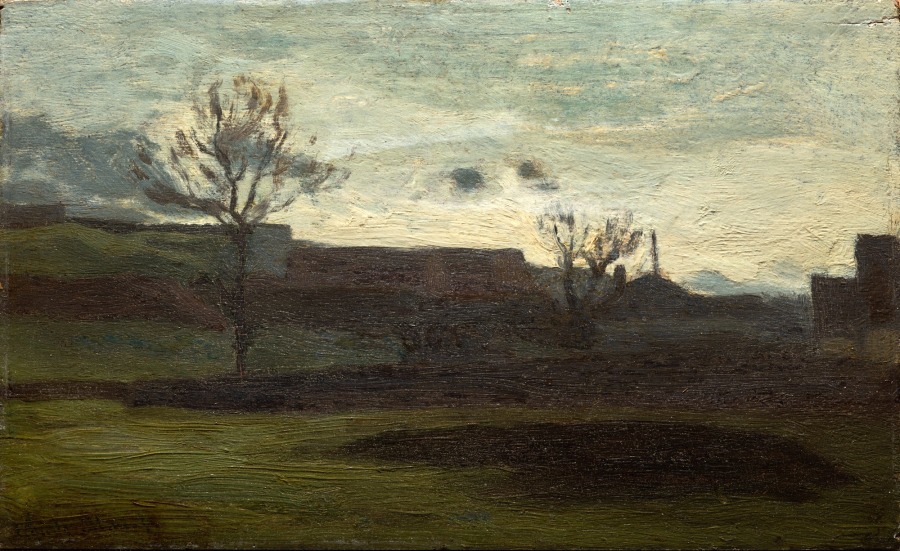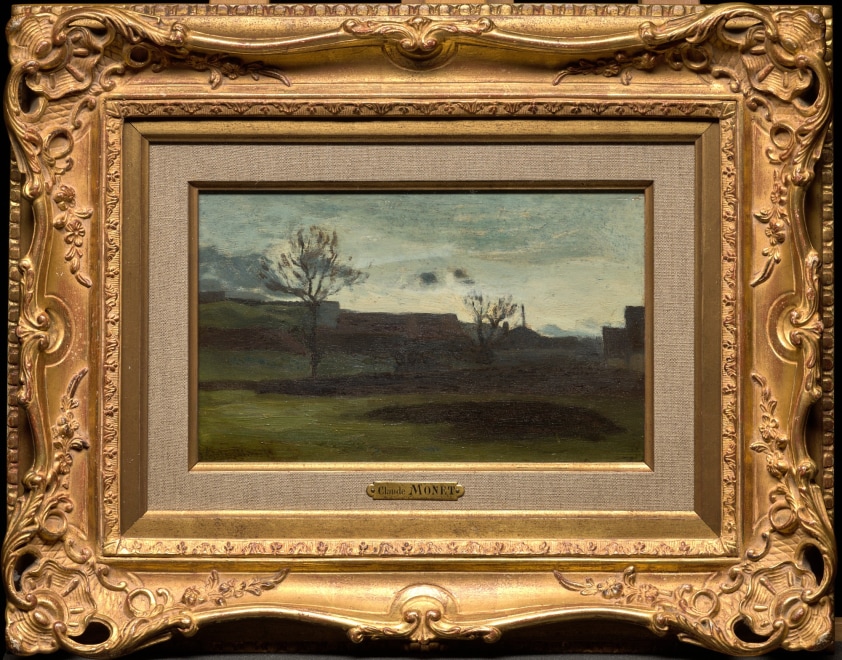Provenance
Sale, Paris, Galliera, 6 December 1975, lot 111
Comte de Senneville (acquired at the above and sold, Enghien, hôtel des ventes, 18 November 1979, lot 21 bis)
Art Point, Tokyo, 1982
Private collection, Japan
Literature
Daniel Wildenstein, Claude Monet, Vie et Œuvre, vol. V, Lausanne, Wildenstein, 1991, no. 1984, p. 2, 3 (ill.)Daniel Wildenstein, Claude Monet, Catalogue raisonné, vol. II, Lausanne, Wildenstein Institute/Tashen, 1996, no. 5a, p. 9 (ill.)
Catalogue note
Before the shimmering lilies of Giverny, before the misty mornings on the Thames and the radiant hues of haystacks at sunset, there was a young Claude Monet, standing at the edge of a changing world. Somewhere between 1858 and 1861, likely in his native Normandy, the teenage Monet painted Paysage - Usines, a small oil on panel whose quiet presence offers a surprising early glimpse into the future Impressionist’s evolving vision. This painting, little known to the general public and tucked away in private collections for much of its life, captures not only an industrial scene, but also a moment of artistic transition, both for Monet and for the world around him.
The work measures roughly 6.7 x 11.4 inches, modest in size and subdued in palette. It shows a landscape not of pastoral peace or rugged coastlines, but of subdued, almost anonymous industrial outskirts. Bare trees rise against a cloudy sky. In the background, low, dark silhouettes of buildings stretch across the horizon—factories, it is believed, though Monet renders them with restraint and near-abstraction. The structures are more suggested than detailed, blending with the murky horizon. There are no smoking chimneys, no bustling laborers, no explicit signs of industry. Yet the title, Paysage - Usines—“Factory Landscape”—tells us what we are meant to see: the encroachment of modern life upon the natural world.
At the time he created this piece, Monet was still very young, perhaps only 18 or 20 years old. Born in 1840 in Paris and raised in Le Havre, he was beginning to study art more seriously. He had just begun to move beyond caricatures and coastal sketches, turning instead toward atmospheric studies and the influence of realists and proto-Impressionists like Eugène Boudin (1824-1898) and members of the Barbizon School. These artists encouraged him to paint not just the grand or the picturesque, but the everyday—to observe light and form as they actually appeared in nature. Paysage - Usines belongs to this experimental period, when Monet was still learning to see the world through paint.
And what did he see? A world in flux. France in the mid-19th century was undergoing vast industrial transformation. Railways carved through forests and farmlands, factory towns sprouted where villages once stood, and smokestacks began to define urban skylines. Artists, too, were grappling with these changes. While some romanticized the countryside or turned away from modernity altogether, others, like Monet, began to absorb its imagery into their visual language. But Paysage - Usines does not romanticize or critique. It simply observes. It captures the stillness of a post-industrial twilight, a space both inhabited and emptied, touched by human presence but not dominated by it.
Unlike the vibrant, light-filled canvases Monet would later become known for, Paysage - Usines is muted in both palette and mood. The earth tones—browns, greens, and grays—convey a somber stillness, while the tight, deliberate brushwork reveals a young artist still honing his craft. And yet, even in this modest panel, there is a striking modern sensibility: a sensitivity to atmosphere, a quiet tension between nature and industry, and an unflinching gaze at a world in transition. The very act of choosing a factory landscape in the late 1850s was a forward-looking gesture—an early indication that Monet was already observing how modern life was reshaping the environment, even before plein-air painting or Impressionist color had entered his vocabulary.
In that sense, Paysage - Usines is less an anomaly than a premonition. It suggests that Monet’s genius lay not only in his technique, but in his vision: his instinct to look directly at the world around him, whether it glowed with dappled sunlight or loomed under overcast skies. His later works would burst with color, break with convention, and transform painting forever. But here, in this quiet panel, we find him on the cusp—young, observant, and already drawn to the uneasy beauty of a changing world. And so, Paysage - Usines endures not just as a rare early work by a master, but as a small, powerful document of how the 19th century looked—and how it began to be seen. In its shadowy forms and thoughtful quiet, it contains the earliest murmur of what would become one of art’s great revolutions.
This note was written by Elsa Dikkes.




